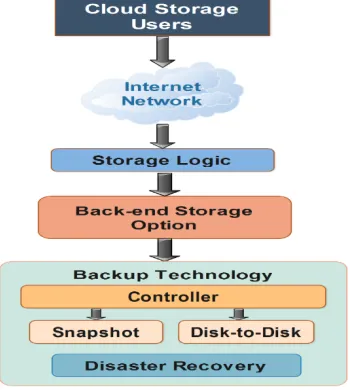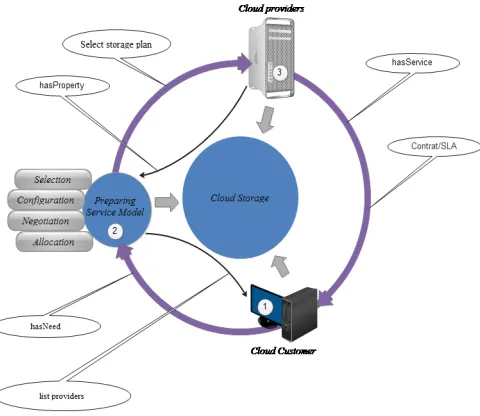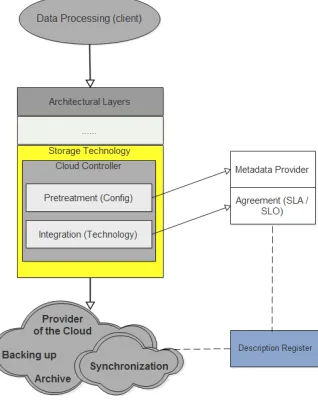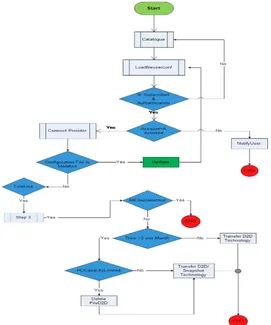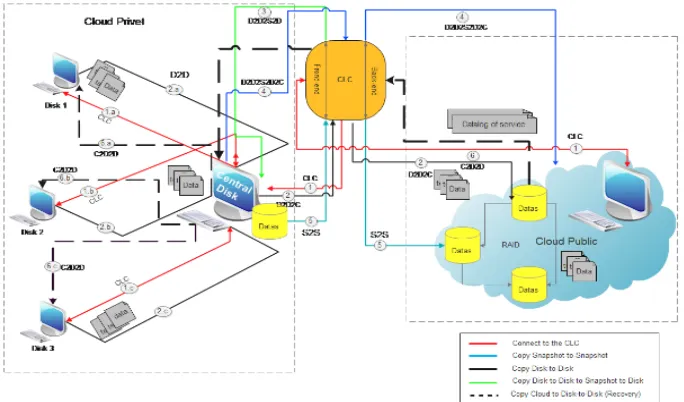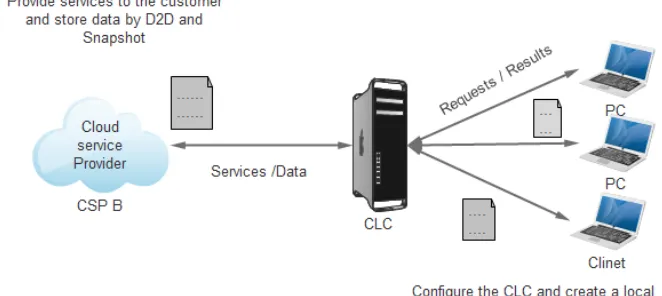A Novel Model of Data Storage Service in the
Architecture Cloud Storage
https://doi.org/10.3991/ijoe.v15i07.10094
Hatem Taha (*), Noura Aknin, Kamal Eddine El Kadiri
Abdelmalek Essaâdi University, Tetouan, Morocco haatem.taha@gmail.com
Abstract—Cloud storage is the lower layer of the cloud computing system that supports other layers above it. Up to now the likes of Google, Microsoft, IBM, and Amazon have been providing cloud storage services. Since its effi-cient way to store and manage important data, the offer of free storage attracts researchers. As a result, cloud storage research will not only track trends, but will also have high application value. Therefore, this paper, introduces a novel model of data storage and backup in cloud storage, that optimally combines customer storage resources with service providers, so that redundancy, storage strategy and configuration properties can be adjusted adequately to the needs of the storage service consumer. In this paper, we review two of the backup tech-nologies (Snapshot and D2D), that are used in this model. In addition, the first contribution is bound to both determining consumer requirements and choosing the provider. Next—life cycle and phases of preparation model for data storage services. Furthermore, we present place and form of the model in cloud storage architecture. The model aims to increase the availability of data and reduces the loss of data in storage environments.
Keywords—Architecture, cloud storage, storage; modeling, backup, storage technology
1
Introduction
im-portant of solutions associated with challenges of backup data. Cloud Storage inte-grates Grid Computing, Distributed Systems, Virtualization, Load Balancing and other traditional network technology. It is high reliable, scalable and highly efficient.
Testing the model of the system with the real infrastructure is usually limited by specific infrastructure and takes a lot of money to set up the experiment environment and it is often difficult to repeat the experiment. Therefore, a feasible way for devel-opers for testing any system is by using simulation tools. Simulation tools enable developers to repeat experiments in a controllable environment and can also be down-loaded and installed free of charge. In this paper, we propose CloudSim: an extensible simulation toolkit that enables modeling of Cloud storage environments [3]. It enables seamless modeling, Implementation, simulation, and creation of one or more virtual machines (VMs) and experimentation of cloud computing environment and applica-tion services. It also allows simulaapplica-tion of multiple Data Centers.
This article, extending and generalizing previous research on the optimal model of cloud storage architecture [IBM], contributes to a more holistic view of entire re-source service systems, especially concerning the achievement of optimality for data availability, high performing, and cheap storage, resource-conservative and effortless use thereof. Among the available resource services, it concentrates on the technology and the strategy of data storage. This article explains the implementation and model-ing of the fourth layer in cloud storage architecture.
The contribution proposed in this article is a model of data storage inspired by the hybrid solution of computing in the cloud. This service is hosted by a client machine or computer server or platform of a provider. It is called Control Cloud Storage (CLC) which is able to collect a very large number of available storage services, to provide storage strategies on heterogeneous computing resources of diverse origin, to manage storage technologies of a simple way and analyze the needs of users.
2
Key Concept and Terminologies
This section presents background information on various architectural elements for basis of Cloud Storage. It also presents requirements of various applications that need to implement this model as an alternate approach for achieving the acceptable solu-tion.
2.1 Storage-as-a-services (STaaS)
Storage-as-services: are systems, which provide storage services to customers via the Internet that uses virtual technology (virtualized storage device). Integrates vari-ous storage devices of the network by a different application, which use a large amount of network bandwidth required to conduct storage. Cloud storage provides many different access interfaces for all application cloud storage architecture.
the internet service, which we will study it in the next search, such as performance, scalability geographic, network security, availability and data encryption [4].
Cloud storage can provide high reliability and security storage service at competi-tive price. Also, customers have the option to trade the privacy of their data for the convenience of storage services [5]. There are more than 60 CSPs (cloud storage providers) that deliver economies of scale by using different storage capacities to meet the needs of many organizations, passing the cost savings to their customer bases, such as Amazon, Google, Microsoft and Dropbox. It can be an acceptable solu-tion to keep up storage infrastructure and addisolu-tionally to mitigate the risk of the data loss just in case the disaster. All customers know that there is a need for maintaining simplicity, scale back data storage prices, freedom from vendor lock-in, improve availability data, continuity and sensible performance.
From this groundwork, we see that may provide an opportunity for some emerging enterprise with growing their data. Also, this may be an effective solution, which store resources in the cloud for government, enterprise and users. These users can at anytime, anywhere, through any device connected to the Internet cloud and easily access the data. In terms of work, there are a lot of problems and challenges exist.
2.2 Cloud snapshot technology
In this section, we would like to provide the reader a quick outline of some uses snapshotting generally, to understanding the opportunities and addressing a broad array of interconnected challenges for the structure of cloud storage. We will describe the snapshot cloud in architecture cloud storage and explain its underlying challenges at the core issue in backup and recovery. In any storage system, the protection of data is probably one of the most sensitive issues. More generally speaking, a snapshot is the state of a system at a particular point in time. High-availability systems may in-stead perform the backup on a snapshot that is a read-only copy of the data set frozen at a point in time and allow applications to continue writing to their data [6]. Snapshot could also provide another data access channel to accelerate I/O performance [6].
It can, therefore be said that the snapshots in the cloud storage system are used to avoid downtime, snapshots technology look and behave like complete backups [7]. There are an also large number of vendors offering different methods for exploiting snapshot to management, use, storage simpler, and consequently, more reliable. To give just two examples: Data Tiering and Remote Replication, these two are prime examples and crucial to any storage system [8], [9].
Snapshots work: Users must identify what they require of their cloud storage pro-viders (CSPs), and to do this they must have a better understanding of how making use of cloud storage. In the context of this work, there are different methods adopted by vendors to create snapshots, each one having its own benefits and its drawbacks. Therefore, it is important to understand snapshot implementations. In a concise man-ner, we will present the primary ways in which snapshots can be incorporated into the cloud storage architecture to enhance data security.
administra-tor to create a new block device and to modify data, and to overwrite the old data of a logical volume. While there are a number of mechanisms that can protect the old data, for instance, ROW “Redirect-On-Write” Redirect-on-write is comparable to copy-on-write. This work focuses on the context in which copy-on-write is produced and mod-ified. Likewise, this reduces the number of writes from two to one, which has to be written in new places and this is one of the most important challenges because the original data set can quickly become fragmented. However, with redirect-on-write, the original copy contains the point-in-time data, that is, snapshot, and the changed data reside on the snapshot storage [7]. While COW “Copy-On-Write” Which allows the user makes changes to the same data "copy of the data", that they may occasional-ly need to modify the same resource, with the preservation of the original resource unchanged. Furthermore, make significant resource savings by sharing resources [7].
The main job of snapshot cloud is to backup or recover data. However, this pre-sents some challenges, particularly in the working long-term and the numbers of the snapshot with these technologies.
2.3 Cloud disk-to-disk technology
In the past few years, Solid State Drive (SSD) has started making its inroads into the enterprise IT environment and which contributed to reducing Hard Disk Drives (HDD) as a storage technology was widely used in the enterprises. For this reason, enterprises need higher input/output (I/O) performance.
Wherefore, we see that the cloud storage is hybrid approach combines new tech-nology and traditional that used to reduce burdens for enterprises especially in the start-up phase, also to protecting the customer's data so that it could be extensively used for storing data and sharing. In response to these issues, some innovators in this space are blending the capabilities of traditional onsite backup systems with cloud storage. This is even more important now, to ensure continued industry trend toward using disk-to-disk (D2D) backup for more frequent and timely data protection for the cloud storage system[10]. In addition, the combination of all these innovations pro-vides maximum protection for the customer data in cloud storage.
For that, we need a cloud storage is accessible to all, safe and scalable, with offsite backup for any data or any system anytime, anywhere, which means access to cheap store services for the customer. Furthermore, we see that these requirements may be realized in the technology Disk-to-Disk which is gaining in popularity in both large enterprises and small businesses [11]. There are in fact a number of hybrid solutions with some hybrid cloud backup tools today, such as Acronis Inc., Commvault Sys-tems Inc. and Symantec Corp.
3
Overview of Available Architecture
have different storage architectures, each has a unique combination of performance, durability, cost, and interface, which is further enhanced by additional factors such as resiliency, availability, scalability and multiple storage options [12], [13].
No architecture has a particular purpose, but the services to which an architecture implements a given feature define its market and its appropriate usage patterns. First, let's discuss a general cloud storage architecture to define the context of unique archi-tectural feature requirements. In general, the cloud storage architecture contains three layers generically [12], (see Figure 1).
Fig. 1. Cloud Storage Architecture [12]
A presentation layer (Front-end): a front-end that exports an API to access stor-age services. In traditional storstor-age systems, this API is the SCSI protocol; but in the cloud, these protocols evolve. There we can find web service frontends, file-based frontends, and even more traditional frontends (such as Internet SCSI, or ISCSi).
A logical storage layer (Middleware): Behind the front end is a middleware layer called storage logic. This layer implements a variety of features, such as replication and data reduction, compared to traditional data placement algorithms.
Layer storage options (backend): The back end implements physical storage for data. This can be an internal protocol that implements specific features or a traditional back-end to physical disks.
4
Propose Model for Data Storage
We discuss the model architecture that has been proposed (Figure 2) to overcome the challenges facing the cloud client and to make the backup layer important in cloud storage. This model proposes a hybrid solution for storing data in the cloud that in-volves three types of actors: cloud data storage service providers (CSPs), cloud stor-age service clients (CSC), and Cloud controller (CLC).
flexible and practical methods for keeping data and their services while reducing the costs associated with service delivery. Generally, this method is useful when evaluat-ing architecture of cloud storage, and to improve storage efficiency, performance, reliability and compatibility. Also, it's an unbiased method because it accurately re-flects the controller between the snapshot and the D2D disk-to-disk for backup. On the other hand, it has particular advantage for modeling backup technology layer.
Fig. 2. The proposed model for data storage
This model can enhance the functionality of the backup layer, facilitate the method of storing the data in the cloud. In addition, the advantages of this type of design are: the use of a wide choice of strategies and the offering of different storage options. This model is also elastic, the cost is calculated according to the use; may configure before using any service of this model and provide better storage services, due to the likelihood of improved storage processes and technologies. Finally, this model allows us to provide a recovery service our data (Disaster Recovery) in an easy way.
4.1 Implantation of CLC in architecture
We now address the list of CLC implementations in the cloud storage infrastruc-ture:
An internal solution to the user: The CLC can include an application that is inte-grated directly into the user's infrastructure and connects the internal user to different cloud storage services.
A hybrid solution: The solution is present in the user's internal disks and certain actions are performed from and to the cloud CLC, the CLC separates this hybrid model into two distinct modules.
4.2 Life cycle and preparation mode
In this phase, users can identify their needs, which can match their purchasing ca-pabilities, and send it to the service model. It brings all the sources that can meet these needs and obtain different properties for each supplier, while reducing the loss of time and effort. The service preparation phase is one of the most important points dealt with by the CLC model. Often, many users of this service fall into the hands of the wrong provider who only meets some of their needs.
It includes four main parameters, in the form of four action verbs: select / config-ure / negotiate / allocate, as shown in figconfig-ure 3.
Configuration: This setting allows us to configure the method of using the tem-plate. It also allows us to identify the type of service and how data is stored in local devices or on the cloud. This type of service can be technologies, strategies, and data storage resources that are managed by this model.
At the beginning of the use of the model, the user must know the characteristics of this parameter, which are manually configured. It has a low cost of administration because of its flexibility and the ease of adding technology and strategy to the model. The configuration of the model includes two sub-parameters: configuration of tech-nology and storage strategy.
Negotiation: It is a set of steps taken to reach an agreement or to close a deal. In general, negotiation is a process by which two or more parties seek to agree what each intends to do or give.
Users can access this step when they know the cloud storage market, choose a pro-vider who wants to exploit their services, and define a storage strategy and technolo-gy. In this setting, we added the contract between the user and a prospective cloud provider. This may be more complex than most other settings. Once we have reduced our choice of cloud service providers, we will need to discuss and clearly define the contract details based on the services we have chosen. This step is validated and sup-plemented by concluding a contract between the user and provider.
Allocation: The other challenge is the allocation of resources that meet user re-quirements and data storage. Cloud storage services are closely related to Internet services. Therefore, it is not possible to provide cloud services in the absence of In-ternet services. This means the impossibility of the availability of external resources to access the data. To solve this problem, we suggested a setting, which allows us to use and store data in local and external resources. This setting also allows us to main-tain the availability of data access. This, additionally reduces losses caused by the disruption of Internet services. It also identifies the resources it wants and can use, whether internal or external.
4.3 Place and form of the model Different forms of solution (CLC):
A virtual machine: It would be preconfigured by the cloud provider for the client. The latter would host it on a hypervisor of his choice.
A physical server: It would be configured and delivered to the client. So the client is dependent on this server to identify the providers and the use of appropriate tech-nologies for the tasks to be performed by him to store his data.
A software package: Which is available via a repository manager (like, the OneDrive package, GoogleDrive, which are available via cloud provider websites): in this case, the user must have the necessary expertise to configure the services. This configuration is operated by the model. In addition, the model can create a folder on different client machines, which would ensure storage and access to data.
Model’s location in cloud storage architecture: Based on the structure of the ar-chitectures in Figure 4, scalability is another characteristic of the proposed architec-ture. The general results of storage are technologies that are based on great sets of standard hardware components; that can be easily developed on demand, at lower cost, as the needs for infrastructure and storage change.
We have worked on a hybrid concept to prevent infrastructure from being inter-rupted, which can solve majority of the most urgent problems and preserve the com-pany's future. The hybrid solutions are the best mixture of traditional computing, private cloud and public cloud; which enable us to achieve our business and compu-ting goals by integracompu-ting new technologies where they are needed and maintained.
of many resources and efforts in management, not to forget the costs of these re-sources, all of which prevents the management from adopting the cloud. In our opin-ion, the separation of services in the cloud storage means only an economic and commercial vision rather than preservation of data services ones.
The costs of safeguarding services are different from others, because they are con-sidered as available at the lowest cost.
We base the concept of this solution which enables us to put our proposal between the public and the private, because it combines the services of the cloud and does not exempt at the same time in the user's equipment. The figure 4 shows the site of model in cloud architecture. We see that the independence of this model in a single layer allows us to apply the concept of scalability in services.
This location has been carefully selected to maximize efficiency while minimizing the cost and combination of traditional technologies and cloud technologies that ena-ble us to achieve our goals by integrating these technologies to meet customer re-quirement
Fig. 4. Abstract cloud storage architecture attached to the model (CLC)
5
Propose a Set of Architectural Standards
We present a list of service principals that are run by Cloud Controller (CLC) and that describes the basics and function of the proposed architecture:
Resources: available to cloud storage providers, including the level of data securi-ty, technologies used, service levels.
The management policies of cloud storage vendor stating: whether the cloud pro-vider is using the open and collaborative strategy or is proposing a particular service delivery plan and controlling the user's data.
Capabilities in different contexts: the ability to manage data, ability to switch pro-viders and compliance with laws, etc.
Technologies are free and are belong to various providers of cloud storage.
Location of the service provider, and the ability to locate the data: the need to choose the geographic location that hosts the data, whether the provider provides the location selection service to host data.
The Configuration options available: Identify the methods of data transfer to the service provider, the choice of technology, the knowledge of service providers.
The SLAs offered by each CSPs: to go further, a negotiation with the cloud storage providers on the objectives that these SLAs must support is recommended.
5.1 Performance
It would be useful to test latency, throughput, cost, storage capacity and availabil-ity, etc. The Cloud Controller is thus able to obtain results that will enable it to choose, according to the parameters, a supplier according to the needs of the custom-er. In addition, it is possible to measure the level of trust assigned to a particular pro-vider. Cloud controller hosts the service catalogue of different cloud storage vendors associated with its geographic area.
6
Modeling of Cloud Controller Details
to create new model to exploit from two technologies and get advantages of each one using one service, one count.
6.1 Authentication Model
The authentication model serves to access securely in cloud storage. Although dif-ferent technologies storage: disk-to-disk (D2D) and snapshot. Each service it has an own profile, but our work based on one account to facility access to the cloud storage so we create a new model called “USER”, the profile can be a client of Amazon ser-vices or profile of disk-to-disk (D2D) technology implemented by us. To benefits services from Amazon, we need an Access Key and SecretKey. With two profiles make the task complex. The proposed model combines profiles to one profile account in order to improve scalability, flexibility.
6.2 Key option Model
KEYOPTION is set of constraints and conditions for using Cloud Backup Tech-nology including the size of data, number of copies, duration data on the disk and the cost. It indicates which technology can and should the user use it: SNAPSHOT OR disk-to-disk (D2D). To deal with these constraints we define keys as attributes on a model class called “Parameter” that its values can be configured depending on pro-vider service.
The model proposed save data automatically into volume using snapshot when size of data in volume is less than limited size and number of copies less than one hundred copies into the disk, in other cases “KeyOption” consider disk-to-disk (D2D) as main technology storage. The limited size is the maximal value of data permitted by the provider, so when the total size data in the volume is exceed this value the model automatically change the technology to D2D. The attribute “duration” means how long data still into the disk when user use snapshot as main technology service, but when data exceed sixty days the data will be removed automatically or can the user refer to disk-to-disk (D2D) technology. And finally, “limited copies” is the last attrib-utes that from its name seen is number of copies.
In the cloud storage system, Snapshots and disk-to-disk (D2D) provide significant-ly easier, reliable, effective-cost, automated, and faster backups than any traditional backup system.
6.3 Modeling snapshot technology
As in the site web of Amazon explain that procedure CREATSNAPSHOT serve to create new image for volume EBS, then the second procedure SEACHSNAPSHOT aim to looking for snapshot images which created before.
6.4 Modeling disk-to-disk technology
According to the article [14], disk-to-disk (D2D) enhance the server levels for im-portant data types in the organization by increasing reliability of backup and data protection.
The advantage of this, when user subscribe to a cloud storage service, user can lease one or two kinds of technologies backup from the backup cloud storage, which can access via the API. This model to improve functionality of cloud backup layer, it chooses any type of technology, or both according to the data storage management method or the moving of our interests in the Cloud Storage.
Disk-to-disk (D2D) requires both software and hardware to replicate data to disk on another. In this task, we try to implement disk-to-disk (D2D) technologies by cre-ating the model Disk written by JAVA language. The model has set of disks, which each disk has a D2D identity to describe where data will be transferred.
7
Operation of the CLC
To reach the optimality of storage in the cloud, the customer of services must use and incorporate several resources of storage according to certain models and con-straints. The cycle of life of the model for the services of storage in cloud show the mechanisms that simplify the objectives of the customers and the providers. We will explain the operation of model to each step, starting from customer's choice of a ser-vice cloud, which answers its needs (upon request), until placing the data on the re-sources of the supplier cloud. We have separated the operation in two parts, one in Face-end and the other in back-end.
7.1 CLC model in front end
Aggregation
• Assemble the needs for the customer in one package (Requests)
• Assemble the services of storage in the cloud in catalogue of service and update the offers which provided by the suppliers.
Selection
• Choosing a cloud provider as needed
• Choosing a storage strategy and a data hosting location • Choosing a technique used to store data
To achieve the concept of a hybrid solution, it is necessary to involve the customer in the different solution options, for example in the selection of a supplier, specify requirements and storage methods.
7.2 CLC model in back-end
The process of data storage begins once the provider is selected, and a technology, discussion at the service level and acceptance of the contract. This process begins with locating the user's data and synchronizing his disk (Central Disk in Private Cloud) with the Provider Disks (Disk in Public Cloud). After that, the model makes the data classification by date on the local disk (user). This is after taking a complete copy of the disc using D2D technology and sending it to the external drive (public cloud). Then model uses Snapshot technology that creates two copies of data, one on the local disk and the other on the external disk. This process allows us to keep four copies of the data.
8
The Algorithm in a Scenario of Data Storage
In this section, we present a scenario of operation the algorithm for the solution CLC for data storage between cloud private and cloud public (figure 6). To test the effectiveness of the proposed solution (CLC hybrid solution) in our work, we used the CloudSim simulation program and we created models of the private cloud (left), the public cloud (right) and a CLC model (Centre) that consists of: Cloud Controller; Snapshot technology; Disk-to-Disk technology.
(provider site), in the event of a site-wide data loss, such as a fire or flood. Precisely by devising the controller layer to two new other sub-layers: authentication and KeyOption based on CloudSim as the simulator.
A controller can be seen as a manager that ensures that all resources needed for da-ta storage, backup and recovery are available. This is based on a cloud Storage Model. In the fourth layer are used two technologies for backup (snapshot and Disk-to-Disk).
In other terms, we add a particular work that one controller controls the whole Cloud Backup Technology, it includes list of users and list of its data as an instance of IOStreams class in JAVA. The user authenticates and chooses the technology recom-mended by our model automatically or manually by user himself to ensure this proce-dure perfectly. We add new model as sub-layer called controller which is seen from its name it controls all operations of users in the Cloud Storage.
8.1 Resultant of operation algorithm
Algorithm of model provides a good methods of data protection, and it also gives access to the data constantly and in all the situations. Thanks to our hybrid solutions (model CLC), the resulting model is capable of creating wide copies for data storage available on clouds and on local (see figure 6):
Fig. 6. Architecture data storage with algorithm of CLC
D2D: (Local) Disc to Central Disc (Private cloud).
D2D2D or (D2D2C): (Local) Disc to Central Disc (Private Cloud) to (Public Cloud) Disc.
D2D2S2D: Local Disc to Central Disc (Private Cloud) to Snapshot (Snapshot (lo-cal Disc)) to (Private Cloud) Disc.
D2D2S2D2D or (D2D2S2D2C): Local Disc to Central Disc (Private Cloud) to Snapshot (Snapshot (Central Disc)) Private cloud) to (Public Cloud) Disc.
C2D2D: (Public Cloud) Disc to central Disc (Cloud Privet) to (local) Disc. S2D: (Snapshot (central Disc (Private Cloud)) to (local) Disc.
S2S: (Snapshot (Private Cloud) to Snapshot (Public Cloud)).
8.2 Contribution
technologies to increase data security and data availability to the customer. This mod-el CLC can exploit the available capacities for the backup technologies in order to modify the concept of copy and data storage, which means that the protection is the base of storage in the cloud.
Fig. 7. A cloud client uses the model to store and recover data
9
Conclusion and Future Work
10
Acknowledgement
After the achievement of this study, I wish to thank my parents for their financial support, all colleagues who participated directly or indirectly to achieve this modest work, more especially my professors', our direction, administration and finally all colleagues of our laboratory LIROSA.
11
References
[1]D. Bermbach and S. Tai, “Eventual consistency: How soon is eventual? An evaluation of Amazon S3’s consistency behavior,” in Proceedings of the 6th Workshop on Middleware for Service Oriented Computing, 2011, p. 1. https://doi.org/10.1145/2093185.2093186
[2]S. Ghemawat, H. Gobioff, and S.-T. Leung, “The Google File System,” 2003, pp. 29–43. [3]R. Buyya, R. Ranjan, and R. N. Calheiros, “Modeling and Simulation of Scalable Cloud
Computing Environments and the CloudSim Toolkit: Challenges and Opportunities,” arXiv0907.4878 [cs], Sep. 2009.
[4] “What is Storage as a Service (SaaS)? - Definition from WhatIs.com,” SearchStorage. 01-Dec-2015.
[5]S. Kamara and K. Lauter, “Cryptographic Cloud Storage,” in Financial Cryptography and Data Security, R. Sion, R. Curtmola, S. Dietrich, A. Kiayias, J. M. Miret, K. Sako, and F. Sebé, Eds. Springer Berlin Heidelberg, 2010, pp. 136–149. https://doi.org/10.1007/978-3-642-14992-4_13
[6]C. Lijun, L. Zhaoyuan, and J. Weiwei, “A snapshot system based on cloud storage Log-Structured Block System,” in 2014 IEEE 11th International Conference on Networking, Sensing and Control (ICNSC), 2014, pp. 392–398.
[7]“Understanding and exploiting snapshot technology for data protection, Part 1: Snapshot technology overview.” 06-Dec-2015.
[8]B. Lakshmi, “ARCHIVING AND MANAGING REMOTE SENSING DATA USING STATE OF THE ART STORAGE TECHNOLOGIES,” The International Archives of the Photogrammetry, Remote Sensing and Spatial Information Sciences, Hyderabad, India, pp. 1153–2014, 2014.
[9]A. P. Amarendran, T. Chatterjee, and P. Varadharajan, “Automated, tiered data retention,” 07-Dec-2014.
[10]G. Schulz, Cloud and Virtual Data Storage Networking. CRC Press, 2012.
[11] “D2D Backup: Disk’s dual role - Storage Technology Magazine,” SearchStorage. 20-Oct-2015.
[12]M. T. Jones, “Anatomy of a cloud storage infrastructure,” IBM developer works (Novem-ber 30, 2010), 2010. [Online]. Available:
https://www.ibm.com/developerworks/cloud/library/cl-cloudstorage/. [Accessed: 09-Jan-2018].
[13] “Les architectures de cloud computing et de stockage dans le cloud | Seagate.” [Online]. Available: https://www.seagate.com/fr/fr/tech-insights/cloud-compute-and-cloud-storage-architecture-master-ti/. [Accessed: 04-Apr-2018].
[14] “How to implement disk-to-disk backups.” [Online]. Available:
12
Authors
Hatem Taha is a PhD Research Scholar in Computer Science, at the Laboratory of Informatics, Research Operational and Statistic Applied (LIROSA) at Faculty of Sciences, Abdelmalek Essaadi University. His dissertation research, focus on data storage in cloud computing. Mouenis have a Master's degree in Quality of programme from Abdelmalek Essaadi University in 2013, Tétouan, Morocco and a BSC in Computer Management Systems and Networks, Faculty of Science, University Moulay Ismail n 2011, Meknes. He has produced several technical outputs, including papers, technical presentations, processes, among others in the field of adaptive systems management. His research areas are Data storage, Network, E-Learning. Email: Haatemtaha@gmail.com
Noura Aknin is a Professor at the faculty of sciences at Abdelmalek Essaadi Uni-versity, and he is with the Information Technology and Modeling Systems, that is unit of LIROSA Laboratory of Informatics, Research Operational and Statistic Applied (LIROSA) at Faculty of Sciences, Abdelmalek Essaadi University, Tétouan, Moroc-co. Email: aknin@ieee.org
Kamal Eddine El Kadiri is a director of the Laboratory of Informatics, Research Operational and Statistic Applied (LIROSA) at Faculty of Sciences, Abdelmalek Essaadi University, and Tétouan, Morocco. Email: kelkadiri@uae.ac.ma
![Fig. 1. Cloud Storage Architecture [12]](https://thumb-us.123doks.com/thumbv2/123dok_us/561525.2055448/5.595.183.416.255.414/fig-cloud-storage-architecture.webp)
